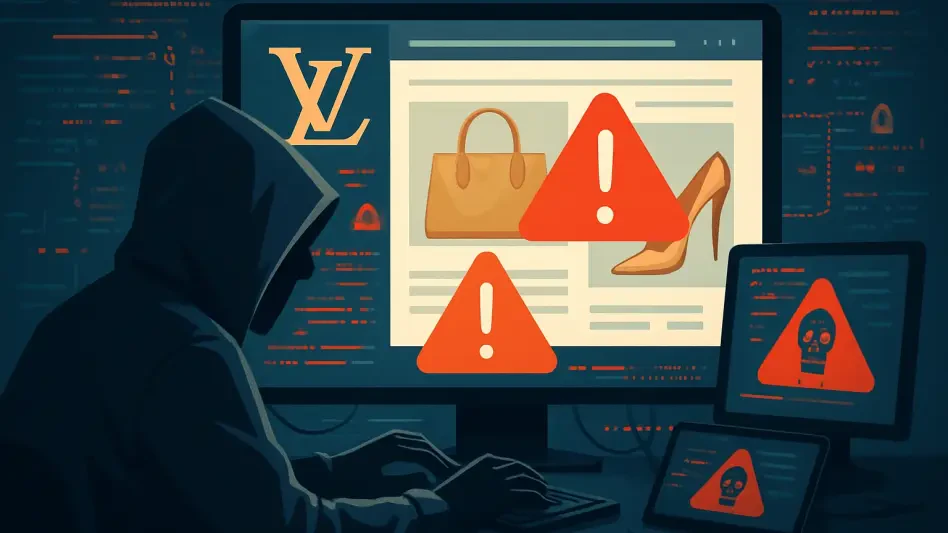Imagine a world where even the most prestigious luxury brands, symbols of exclusivity and trust, fall prey to invisible attackers lurking in the digital shadows, exposing vulnerabilities in their systems. In a staggering breach discovered in June, Kering—the Paris-based parent company of iconic fashion houses Gucci, Balenciaga, and Alexander McQueen—found itself at the center of a cyber storm. This incident, attributed to the notorious hacker group ShinyHunters, compromised the personal data of millions, exposing the fragility of cybersecurity in high-value retail. This review delves into the technology and systemic failures behind the breach, analyzing the implications for luxury brands and their customers in an era of escalating cyber threats.
Unpacking the Scale of the Cyberattack
The breach at Kering, which occurred in April and came to light two months later, affected a staggering 7.4 million unique email addresses. Hackers accessed a trove of sensitive information, including names, phone numbers, and home addresses. While Kering confirmed that no financial data such as credit card numbers was stolen, a sample of the leaked data reviewed by external sources revealed spending details of high-value clients, some of whom had expenditures surpassing $86,000. This level of detail in the wrong hands amplifies the potential for targeted fraud.
The technology implicated in this breach points to vulnerabilities in data storage and access control systems. ShinyHunters, a group known for exploiting weaknesses in corporate networks, likely capitalized on gaps in Kering’s digital defenses. The absence of disclosed specifics about how the infiltration occurred raises questions about the robustness of the company’s cybersecurity architecture and whether outdated systems or inadequate monitoring played a role.
Kering’s Response and Technological Shortcomings
In the aftermath, Kering moved to secure its IT infrastructure and notified affected customers through email alerts, while also reporting the incident to data protection authorities. However, the lack of transparency regarding the entry point of the attack suggests potential flaws in incident reporting protocols. This opacity hinders a full understanding of whether the breach stemmed from a phishing exploit, unpatched software, or another technical lapse.
From a technology perspective, the response highlights a reactive rather than proactive stance on cybersecurity. Modern enterprise solutions often include real-time threat detection powered by artificial intelligence, yet there’s no evidence that such tools were effectively deployed here. This gap underscores a critical need for luxury brands to integrate advanced security measures that can preemptively identify and mitigate risks before they escalate into full-blown crises.
Ransom Dynamics and Ethical Technology Use
A murky subplot in this saga involves conflicting narratives around ransom demands. ShinyHunters claimed to have engaged in negotiations with Balenciaga for a $750,000 payment in Bitcoin, alleging an initial transfer before the deal collapsed. Kering, aligning with law enforcement guidance, publicly denied any such interactions or payments, spotlighting the ethical dilemmas of engaging with cybercriminals through digital currencies.
The use of Bitcoin in ransom scenarios reflects a broader challenge in cybersecurity technology: the traceability and regulation of cryptocurrencies. While blockchain offers some transparency, it remains a double-edged sword, often shielding the identity of malicious actors. This incident emphasizes the urgent need for clearer policies and tech solutions to deter ransom-driven cyberattacks without compromising corporate integrity.
Industry Trends in Cyber Vulnerabilities
Kering’s breach is not an isolated event but part of a troubling pattern targeting luxury retail, with similar attacks hitting brands like Cartier and Louis Vuitton in the same timeframe. Suspicions of collaboration between ShinyHunters and Scattered Spider—a group notorious for social engineering tactics to extract login credentials—point to a networked approach among cybercriminals. This synergy amplifies the threat level, combining technical exploits with human manipulation.
Technologically, the industry faces a dual challenge of securing both digital platforms and employee behavior. Reports from Google threat researchers about a related Salesforce platform abuse campaign affecting over 700 companies reveal how sophisticated attackers exploit trusted systems. Luxury brands must now prioritize not only endpoint security but also comprehensive training to counter social engineering, a persistent weak link in digital defenses.
Customer Risks and the Role of Tech Awareness
The fallout from the breach poses significant risks to customers, particularly through spear phishing campaigns. Experts warn that the stolen data, including detailed purchase histories, can be weaponized to craft highly personalized fraudulent messages, such as fake requests for updated payment information. This threat underscores the limitations of current consumer-facing security technologies in preventing identity theft or financial scams.
Technology solutions like multi-factor authentication and encrypted communications can offer some protection, yet their effectiveness depends on user adoption. The breach reveals a critical gap in customer education—many may not recognize the subtle cues of a phishing attempt. Luxury brands must leverage tech platforms to disseminate warnings and best practices, ensuring clients are equipped to navigate the heightened risks in the digital landscape.
Cybersecurity Challenges in High-Value Retail
Securing sensitive data in the luxury sector presents unique technological hurdles, from safeguarding sprawling databases to protecting global supply chains. The reliance on third-party vendors and cloud services often introduces vulnerabilities that hackers exploit with alarming precision. Kering’s experience highlights how even well-resourced companies can struggle to maintain airtight defenses against evolving threats.
Human error remains a persistent challenge, especially with tactics like social engineering employed by groups such as Scattered Spider. Technology alone cannot address this; robust training programs integrated with behavioral analytics tools are essential to detect and prevent insider threats. Additionally, regulatory pressures may soon demand stricter cybersecurity standards, pushing brands to adopt more transparent and accountable tech practices.
Future-Proofing Luxury Brand Cybersecurity
Looking ahead, the luxury sector must invest in cutting-edge technologies to fortify its defenses against cyber threats. Innovations like zero-trust architecture, which assumes no user or device is inherently trustworthy, could prevent unauthorized access even within internal networks. Similarly, machine learning algorithms tailored to detect anomalies in data access patterns offer promise for early threat identification over the next few years, from now until 2027.
Collaboration across the industry also holds potential to standardize security protocols and share intelligence on emerging threats. Joint initiatives could drive the development of shared tech solutions, reducing the burden on individual companies. Moreover, integrating customer-facing tools—such as secure apps for transaction verification—could rebuild trust while enhancing protection against fraud.
In reflecting on this cybersecurity crisis at Kering, it became evident that the luxury retail sector stood at a crossroads after the breach was uncovered. The incident exposed critical weaknesses in data protection technologies and response mechanisms, leaving millions of customers vulnerable to sophisticated scams. Moving forward, actionable steps emerged as priorities: brands needed to adopt advanced security frameworks, prioritize transparency in breach disclosures, and foster industry-wide partnerships to combat shared threats. Equally vital was the push to empower customers with knowledge and tools to safeguard their personal information, ensuring that trust in luxury brands could be restored through a renewed commitment to digital safety.








